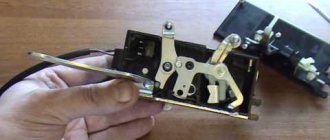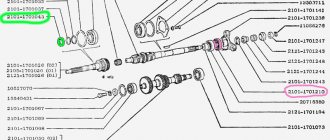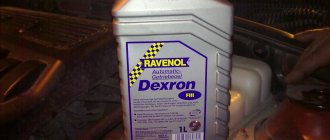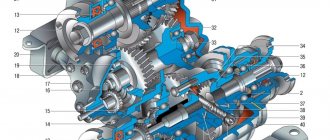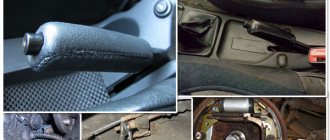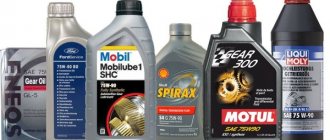The Chevrolet NIVA is a car characterized by high cross-country ability and reliability. Such characteristics are determined by the presence of all-wheel drive with two drive axles. One of the main devices in this car is the transfer case. Structurally, the transfer case is located at the rear of the gearbox. The cardan shaft is attached to its shank. The transfer case performs the functions of low gear and interaxle locking.
Changing the oil in the transfer case of a Chevrolet Niva
For reliable operation of this mechanism throughout its entire service life, a special protective lubricant, which has anti-wear additives, is poured into the transfer case. This oil protects the surfaces of parts from destruction. Over time, the lubricating fluid becomes contaminated and loses its properties. Therefore, it is recommended to periodically replace it. Also, the appearance of external malfunctions may be a signal for an extraordinary change of transmission oil. Transfer case malfunctions can manifest themselves in the following:
- vibration at the beginning of movement, at speed;
- noises, knocking when turning;
- poor gear shifting;
- occurrence of liquid leaks.
Changing the oil in the transfer case of a Niva Chevrolet is a simple but necessary procedure.
Changing oil in transmission units
Before starting work, you need to stock up on a sufficient amount of transmission.
Each of the units holds the corresponding volume:
- Gearbox - 1.6 l;
- Transfer case - 0.79 l;
- The front and rear axles are 1.15 and 1.3 liters, respectively.
You can immediately buy 5 liters of 80W-90 transmission that meets the GL4/GL5 quality standard. It is suitable for all transmission units.
It is also necessary to stock up on flushing oil, which allows you to get rid of oxidation products and decomposition of lubricant components.
Changing the gearbox oil
To carry out the work you will need:
- wrench 17;
- container for collecting waste;
- hexagon 12;
- funnel;
- clean rag.
The transmission is replaced on an overpass or inspection pit. Otherwise, it will be difficult to get to the drain plug on the Chevy Niva gearbox. Order of operations:
- Warm up the engine to operating temperature. In this case, the oil will have proper fluidity and will completely drain from the crankcase.
- Place a container for collecting waste under the gearbox drain hole.
- Use a rag to clean the areas around the drain and fill plugs.
- Using a 17mm wrench, unscrew the oil filler plug. This will allow air to enter the gearbox housing.
- Use a hexagon to unscrew the drain plug.
- Wait for the entire transmission to drain from the crankcase.
- Use a rag to clean any chips from the magnetic drain plug.
- Fill in a liter of flushing oil.
- Start the engine and let it run for 3-5 minutes. At this time, you can change gears by squeezing the clutch.
- Stop the engine and drain the flushing oil.
- Tighten the drain plug.
- Using a funnel, pour new transmission oil into the drain hole.
- Screw in the filler plug.
- Start the engine and let it run for 5 minutes.
- Stop the engine and check the oil level. If necessary, top up the transmission.
Video instructions for changing the oil in the Shnivy gearbox:
Replacing the transmission in the transfer case
In addition to the keys, rag and waste container listed in the previous section, you will need a refill syringe. The oil in the transfer case is changed when the engine is warm. There is no need to change the transmission oil on a street overpass in the cold - the fluid will quickly cool down, thicken and not completely drain from the transfer case.
Replacement procedure:
- How to properly change the automatic transmission oil on a Chevrolet Aveo T300?
- Place the machine on an inspection pit or overpass.
- Inspect and, if necessary, clean the ventilation valve.
- Clean the box around the plugs.
- Place the waste container.
- Unscrew the filler and drain plugs.
- Drain the transmission.
- Clean shavings from the magnet.
- Screw in the drain plug.
- Using a filling syringe, fill the transmission into the transfer case.
- Screw in the filler plug.
Replacement in Chevrolet Niva axles
Considering the location of the filler holes, you need to unscrew the plug with a socket head and a wrench, and not with a regular wrench. Otherwise, the set of required tools and materials is the same as that needed to change the oil in the transfer case:
- 3 liters of gear oil;
- hexagon 12;
- rag;
- refill syringe;
- container for processing.
The procedure for replacing the transmission in the front and rear axles looks like this:
- Drive the car onto an inspection hole or overpass.
- Clean the oil drain and fill plugs, as well as the axle housing near them, with a rag.
- Place a waste container under the drain hole.
- Unscrew the drain plug one by one.
- Wait until the oil stops leaking.
- Screw in the drain plug.
- Fill the transmission into the bridge using a filling syringe.
- Screw in the filler plug.
Changing transmission oil does not require special skills and abilities. Even a novice driver with no car repair experience can perform this operation. You just need to follow the instructions described above and be sure to fill the transmission with the appropriate viscosity and quality.
Gear shift mechanism.
This component consists mainly of a plate with cutouts that are rectangular in shape. All this is enclosed in the main body and is controlled by a lever.
The speed control mechanism is mounted on studs at the rear of the box. The neutral position is located between the third and fourth speeds and is adjusted by bars with spring guides. The plates are located in the guides to provide mechanical movement of the lower part of the lever.
The drive is based on three rods that connect to forks. Forward gears are engaged as a result of the forks entering special holes in the couplings. The rear entry is activated when the fork enters a special hole.
On previous versions, drivers encountered problems with the lever's operation. It was possible to accidentally engage reverse gear instead of fifth. This issue has now been fixed. The solution was found in the form of installing a blocker, which is located at the end of the traction fork.
Now, to engage reverse gear, you need to squeeze the clutch and only then move the lever to position R. In this case, the locking stop drops below the special lining. In order for the mechanism to work properly inside, when the speed is turned on, constant lubrication occurs due to the splashing of oil. Therefore, to prevent oil leakage from the box and dirt and dust not to get inside, the landing places of the primary and secondary shafts are sealed with oil seals.
Changing the oil in the transfer case Niva 21214
The Niva 21214 car is distinguished by its increased cross-country ability on roads. The car has an engine that has a volume of 1.7 liters, which complies with Euro-4 standards. The transmission system includes a transfer case with a crankcase ventilation system. All components on the VAZ 21214, just like on the VAZ 21213, are characterized by a long service life
It is important to take proper care of the automotive system and select high-quality oil for the Niva
The Niva SUV (VAZ 2121), which has all-wheel drive and is equipped with a manual transmission, is capable of producing 75 horsepower.
Selecting gearbox oil
Which oil to choose? Transmission oils are available in a wide range
You should pay attention to fuel that has the following viscosity: 75W-90, 85W-90. In particular, you can choose gear oil Lukoil 80W90 (GL5 class)
Oil in transfer case
When operating vehicles in winter, you should purchase 70W-90 oil, as it has a low viscosity. Semi-synthetic options are also suitable for refueling Niva 21213. It is better to carry out replacement at a specialized service center.
How much oil to fill? Approximately 0.8 liters of oil must be added to the Niva distributor. 1.6 liters of transmission fluid is poured into its high-speed box.
Before choosing a transmission fluid, you should always carefully study its composition.
The need to change transmission oil
To change the oil on a Niva, the car must be warmed up (to ensure good fluid fluidity). The machine is placed on an inspection hole; a special container should be placed under the drain hole into which the waste liquid will drain. To open the drain and fill plug, you should use a hexagon. Also, as an additional tool, you will need a special syringe, which is used to fill the transfer case with fuel.
Changing the oil in the transfer case (Niva 21214 / 21213). Main stages:
- The drain plug is unscrewed.
- The remaining oil is poured into the container.
- Any contamination on the plug must be eliminated.
- The drain plug is screwed in.
- The top plug is unscrewed to fill in new oil using a syringe.
- The plug is screwed in.
The peculiarity of the gearbox is that it has a built-in magnet. Its function is to attract small metal debris that may be present in the fuel.
When replacing fuel, the crankcase must be flushed. This procedure helps to extend the operational life of the box. Flushing is required if the drained oil is heavily contaminated.
The frequency of changing fuel for the transmission is affected by the mileage of the Niva 21214 (21213) and the conditions under which it is used. When making frequent off-road trips, the need to change the oil for the transfer case and gearbox may arise up to 50,000 km.
The need to add a new lubricant to the box can be indicated by the fact that the gearbox began to overheat and characteristic noises appeared on its side during movement.
Changing the oil in the automatic transmission of a Lada Granta: how to change the transmission fluid correctly
Changing oil in transmission units
Before starting work, you need to stock up on a sufficient amount of transmission.
Each of the units holds the corresponding volume:
- Gearbox - 1.6 l;
- Transfer case - 0.79 l;
- The front and rear axles are 1.15 and 1.3 liters, respectively.
You can immediately buy 5 liters of 80W-90 transmission that meets the GL4/GL5 quality standard. It is suitable for all transmission units.
It is also necessary to stock up on flushing oil, which allows you to get rid of oxidation products and decomposition of lubricant components.
Changing the gearbox oil
To carry out the work you will need:
- wrench 17;
- container for collecting waste;
- hexagon 12;
- funnel;
- clean rag.
The transmission is replaced on an overpass or inspection pit. Otherwise, it will be difficult to get to the drain plug on the Chevy Niva gearbox. Order of operations:
- Warm up the engine to operating temperature. In this case, the oil will have proper fluidity and will completely drain from the crankcase.
- Place a container for collecting waste under the gearbox drain hole.
- Use a rag to clean the areas around the drain and fill plugs.
- Using a 17mm wrench, unscrew the oil filler plug. This will allow air to enter the gearbox housing.
- Use a hexagon to unscrew the drain plug.
- Wait for the entire transmission to drain from the crankcase.
- Use a rag to clean any chips from the magnetic drain plug.
- Fill in a liter of flushing oil.
- Start the engine and let it run for 3-5 minutes. At this time, you can change gears by squeezing the clutch.
- Stop the engine and drain the flushing oil.
- Tighten the drain plug.
- Using a funnel, pour new transmission oil into the drain hole.
- Screw in the filler plug.
- Start the engine and let it run for 5 minutes.
- Stop the engine and check the oil level. If necessary, top up the transmission.
Video instructions for changing the oil in the Shnivy gearbox:
Replacing the transmission in the transfer case
In addition to the keys, rag and waste container listed in the previous section, you will need a refill syringe. The oil in the transfer case is changed when the engine is warm. There is no need to change the transmission oil on a street overpass in the cold - the fluid will quickly cool down, thicken and not completely drain from the transfer case.
Replacement procedure:
- Place the machine on an inspection pit or overpass.
- Inspect and, if necessary, clean the ventilation valve.
- Clean the box around the plugs.
- Place the waste container.
- Unscrew the filler and drain plugs.
- Drain the transmission.
- Clean shavings from the magnet.
- Screw in the drain plug.
- Using a filling syringe, fill the transmission into the transfer case.
- Screw in the filler plug.
Replacement in Chevrolet Niva axles
Considering the location of the filler holes, you need to unscrew the plug with a socket head and a wrench, and not with a regular wrench. Otherwise, the set of required tools and materials is the same as that needed to change the oil in the transfer case:
- 3 liters of gear oil;
- hexagon 12;
- rag;
- refill syringe;
- container for processing.
The procedure for replacing the transmission in the front and rear axles looks like this:
- Drive the car onto an inspection hole or overpass.
- Clean the oil drain and fill plugs, as well as the axle housing near them, with a rag.
- Place a waste container under the drain hole.
- Unscrew the drain plug one by one.
- Wait until the oil stops leaking.
- Screw in the drain plug.
- Fill the transmission into the bridge using a filling syringe.
- Screw in the filler plug.
Changing transmission oil does not require special skills and abilities. Even a novice driver with no car repair experience can perform this operation. You just need to follow the instructions described above and be sure to fill the transmission with the appropriate viscosity and quality.
Changing the oil in the Chevrolet Niva transfer case
When choosing a liquid for a dispenser, you need to consider its compatibility with other technical compounds. Be sure to check the compliance of lubricant viscosities and chemical parameters. Any ill-considered mixes worsen the performance of the car.
Important! It is not necessary to take products from the same manufacturer, but you need to pay attention to the compliance of the viscosity parameters of the lubricant
The procedure for replacing the working fluid in the Niva transfer case has its own characteristics that should be taken into account
Before changing the lubricant, the transfer case is warmed up - you can drive 5 km. Perform work on an overpass, lift, inspection pit. First, remove dirt from the fill and drain plugs and remove them. Be sure to inspect the built-in magnet and clean it of dirt (if any).
The waste flows into the prepared container; when the process is completed, the drain plug is screwed in, the fill is unscrewed - new oil will need to be added to it using a syringe.
Important! Additionally, it is worth checking the condition of the breather and, if necessary, cleaning it. Do the same with copper O-rings.
Tips for changing the oil in a Chevrolet Niva manual transmission
In order to carefully and timely carry out maintenance in accordance with the vehicle’s operating instructions, it is recommended to remember the current mileage mark. This will allow you to avoid mistakes when setting the date for the next car transfer case oil change.
Experienced motorists recommend changing the oil not only in the transfer case. At the same time as the gearbox, the oil is also changed in both Niva Chevrolet axles. Therefore, the list of preparatory work must include the purchase of oil for the Niva axle gearbox.
When choosing the most suitable gear oil, the price of the product is not the only indicator of its quality. The cost of oil products also depends on the name of the famous brand. The main condition for the smooth operation of the gearbox is compliance with the recommended service intervals for replacing transmission oil.
If a car is purchased secondhand, it has accumulated mileage and acquired hidden defects. Here you need to be more responsible about changing the oil and reducing the periods between maintenance activities. It is recommended to check the oil level of such a car at least twice a week. When the volume of transmission oil decreases, the risks of serious deviations in the operation of the vehicle as a whole increase.
In this article we will talk about how to change the oil in the gearbox, transfer case and axles of a Chevrolet Niva. The use of high-quality lubricants for vehicles plays an important role in the operation of any car. The most common process for proper vehicle operation is the oil change process. It is possible to change the oil yourself, without resorting to the help of auto service employees, while significantly saving money.
Changing the bearing
We prepare the bit, hammer, sealant and a special puller for the retaining rings, after that:
- Removing the wheels
- We take out the retaining ring from the bearing, to do this we take a wooden spacer and knock the bearing off the shaft with a hammer
- The wheel has an inner CV joint from which the oil seal must be removed
- We lubricate the working edge of the oil seal, and apply sealant to the outer part.
- We take a hammer and press the oil seal back into place, after which we install all the parts back.
The Chevrolet Niva front axle gearbox must be removed if repairs or replacement are necessary. In order to carry out all the necessary actions you need to have special equipment and certain skills. If the work is carried out in a garage, you may not achieve the desired results. Therefore, if you do not have experience in replacement, then it is advisable to contact specialists for a special service.
Manufacturer's approvals
The following are the main categories of tolerances for the transfer case transmission unit of the Chevrolet Niva.
SAE
Depending on the operating temperature limits, the following categories of lubricants are used for the Chevrolet Niva model:
- 75W90;
- 80W90;
- 80W85.
In some cases, the use of other categories of lubricants in Shniva is allowed. However, filling is possible only if it complies with the ambient temperature.
API
The transmission units of the Chevrolet Niva contain bronze synchronizers, which does not allow the use of GL-5 category oils. Specifically for manual transmissions and transfer cases, the GL-4 variety is used. This feature (low-quality lubricant is poured into a critical unit) is caused by the unusual composition of the liquid. Below is a detailed description of each variety.
GL-4
The category is distinguished by the absence of modern extreme pressure additives. The lubricant is compatible with non-ferrous and ferrous metals, plastics, and rubber seals.
Area of application – high-speed, loaded gearboxes of the automotive and industrial type.
GL-5
A newer composition, distinguished by the presence of sulfur-phosphorus additives. Inclusions are aggressive to bronze, copper, brass, which destroys the surface of the part, leading to irreversible consequences and unexpected breakdowns.
The composition is 100% compatible with the designs of bridges and high-speed gearboxes.
Note! If you have difficulties with independently selecting a working mixture, it is recommended that you contact a qualified specialist in a specialized workshop.
Selecting transmission oil for Niva-Chevrolet
According to the maintenance regulations, the gearbox oil needs to be replaced after the first 60,000 km. After long-term operation and a total mileage of 120,000 kilometers, the transmission oil for the Chevrolet Niva is changed after the next 45 thousand kilometers. This is due to increased wear of working parts and transfer case units. It often happens that after 150,000 km it is necessary to dismantle worn elements and install new samples.
Before purchasing a new lubricant, you need to understand the brand of oil that is suitable for the gearbox of a particular vehicle. The Chevrolet Niva model has increased cross-country ability thanks to its all-wheel drive design. Lubricant solutions poured into the gearbox, power unit, front and rear axles differ in many technical characteristics
The main attention in choosing a lubricant for each unit is paid to the viscosity index, because
When operating a vehicle, different temperature conditions are created in the components.
What kind of oil to pour into the Chevrolet Niva transmission. It is recommended to fill the gearbox of a Niva Chevrolet car with a lubricant that meets the requirements of the SAE 78w-90 or 80w-85 standards, API-4 category. Among experienced car enthusiasts, the most popular are the following well-known global brands for the production of gear oil:
- Shell;
- THK;
- Zic;
- Mobil-1.
How much oil is in the Niva Chevrolet gearbox. The relatively small volume of oil in the Niva Chevrolet gearbox is due to the design features and specific operation of the manual gearbox. To change the oil in the gearbox of this car, you need to stock up on 0.8 liters of fluid.
Functioning of the checkpoint
The Niva Chevrolet gearshift mechanism is five-speed mechanical. Its main function is to change the torque transmitted from the engine to the wheels. The manual transmission has a three-shaft design. Unfortunately, the Niva Chevrolet gearbox, having a complex design, often fails. It should be noted that its repair is quite expensive. Therefore, it is important to periodically check the lubricant level and change the oil in the gearbox on time.
For this purpose, transmission fluid of API GL-4 standard with viscosity of 75W-90 and 80W-90 is used. They are produced by both domestic manufacturers (TNK and Lukoil) and foreign ones - Shell, Mobil, Castrol, Total, ZIC, Motul. Of all the above, the French lubricant Motul Gear 300 75W-90 showed the best performance in terms of protection against scuffing, film stability on contacting surfaces, and anti-wear characteristics.
In second place was Castrol Syntrans Transaxle 75W-90 transmission fluid, third was Mobil Mobilube 75W-90 oil. All of them can operate at temperatures from -35 to +35°C, ensuring easy gear shifting and stable operation of the manual transmission. The price of these products is quite high, so it is worth paying attention to the domestic semi-synthetic transmission made by Lukoil - TM-4 75W-90. It is not much inferior to foreign competitors, but at the same time it is much cheaper and better adapted to low temperatures. The manufacturer also allows the use of transmission fluids of viscosity 80W-90 and 80W-85.
It should be remembered that you cannot fill the gearbox with API GL-5 standard transmission oil. In terms of its performance, it seems to be better - it can operate at high speeds and loads, as well as high temperatures. But it contains sulfur-phosphorus extreme pressure additives, a large amount of which can simply “kill” the gearbox synchronizers. They contain bronze, not durable steel. A large number of such additives are contraindicated for her. Therefore, compositions of the GL-5 standard should be poured into axles and gearboxes.
Windshield and brake fluid reservoir
Another filling capacity of the Chevrolet Niva is two glass washer reservoirs, the capacity of which is five and two liters.
This model has two independent braking systems. The working one has a hydraulic drive, the parking one has a mechanical drive. The contours are separated from each other.
The hydraulic drive includes a special tank made for brake fluid. Recommended fluids for pouring into other containers and for lubricating joints:
- DOT-4 brake fluid is suitable for half-liter hydraulic brakes. The product has improved characteristics and has a boiling point of over 235 degrees. Well suited for regions with low ambient temperatures;
- SAEJ1703, FMSS116 are used for the entire hydraulic system and clutch release (0.15 l). The synthetic product provides good lubrication and reduces oxidation at high temperatures;
- tank lid hatch hinges, door and hood locks require VTV-1, FIOL-1 greases. Hinges of steering rods and cardan shafts - ShRB-4, Litin 2, Esma;
- The air conditioner also has two containers. One of them is for oil (0.22 l), the other is for refrigerant (0.650 kg).
Chevrolet Niva reservoirs for refilling liquids and lubricants are quite reliable and convenient when you need to make a replacement.
Various tags and sensors make it possible to carry out control almost immediately, which allows you to avoid an emergency situation.
Changing the oil in the transfer case Niva 21214
The Niva 21214 car is distinguished by its increased cross-country ability on roads. The car has an engine that has a volume of 1.7 liters, which complies with Euro-4 standards. The transmission system includes a transfer case with a crankcase ventilation system. All components on the VAZ 21214, just like on the VAZ 21213, are characterized by a long service life
It is important to take proper care of the automotive system and select high-quality oil for the Niva
The Niva SUV (VAZ 2121), which has all-wheel drive and is equipped with a manual transmission, is capable of producing 75 horsepower.
Selecting gearbox oil
Which oil to choose? Transmission oils are available in a wide range
You should pay attention to fuel that has the following viscosity: 75W-90, 85W-90. In particular, you can choose gear oil Lukoil 80W90 (GL5 class)
When operating vehicles in winter, you should purchase 70W-90 oil, as it has a low viscosity. Semi-synthetic options are also suitable for refueling Niva 21213. It is better to carry out replacement at a specialized service center.
How much oil to fill? Approximately 0.8 liters of oil must be added to the Niva distributor. 1.6 liters of transmission fluid is poured into its high-speed box.
Before choosing a transmission fluid, you should always carefully study its composition.
The need to change transmission oil
To change the oil on a Niva, the car must be warmed up (to ensure good fluid fluidity). The machine is placed on an inspection hole; a special container should be placed under the drain hole into which the waste liquid will drain. To open the drain and fill plug, you should use a hexagon. Also, as an additional tool, you will need a special syringe, which is used to fill the transfer case with fuel.
Changing the oil in the transfer case (Niva 21214 / 21213). Main stages:
- The drain plug is unscrewed.
- The remaining oil is poured into the container.
- Any contamination on the plug must be eliminated.
- The drain plug is screwed in.
- The top plug is unscrewed to fill in new oil using a syringe.
- The plug is screwed in.
The peculiarity of the gearbox is that it has a built-in magnet. Its function is to attract small metal debris that may be present in the fuel.
When replacing fuel, the crankcase must be flushed. This procedure helps to extend the operational life of the box. Flushing is required if the drained oil is heavily contaminated.
The frequency of changing fuel for the transmission is affected by the mileage of the Niva 21214 (21213) and the conditions under which it is used. When making frequent off-road trips, the need to change the oil for the transfer case and gearbox may arise up to 50,000 km.
The need to add a new lubricant to the box can be indicated by the fact that the gearbox began to overheat and characteristic noises appeared on its side during movement.
Reviews
Write your reviews in the comments, we will be grateful
The gearbox is one of the main components of a modern car. The main purpose of this unit is to provide communication between the engine and the wheels and transmit torque. The operation of the box is adjusted using special levers located inside the car. In this article we will try to understand the operating principle of this unit, learn about possible malfunctions and how to eliminate them and maintenance features.
What kind of oil to fill in Chevrolet Niva axles
For maximum functionality of transmission components, it is recommended to fill the axles with the same oil as the transfer case.
Chevrolet Niva owners agree that for axles it is necessary to choose lubricants from well-known brands that have already proven themselves. These include products from manufacturers:
- Mobile,
- Castrol,
- Lukoil,
- Shell,
- Zeke.
But when choosing, you should still observe the compatibility of the composition and viscosity of the oil.
In 90 percent of cases, the Chevrolet Niva is operated off-road, which places high loads on all components of the transmission. And therefore, already at 20 thousand kilometers it is necessary to change the oil, or at least control its quality.
During maintenance, you should soberly assess the condition of the gearbox, transfer case and axles. You should not skimp on lubricants, as this can lead to quite expensive repairs.
Malfunctions
Problems with the gearbox can be identified by several signs. The most common ones are:
- transmission noise
- Difficulty shifting gears
- spontaneous shutdown
- oil leaks on the body
Also on restyled models, a knock appears in the transmission after 5-10 thousand kilometers. In this case, it is necessary to pay attention to the conditions under which the knocking appears.
In rare cases, the link fails. This is the unit that is responsible for the interaction between the transmission and the rod. There are 3 main signs that the malfunction is associated with this particular unit:
- Large lever play
- Problems when selecting gear
- Inability to adjust the mechanism
All problems arising with the transmission require immediate elimination, since this directly affects not only the serviceability of the vehicle but also traffic safety.
Replacing the Niva differential lock warning lamp switch
3 differentials, one in the front and rear axle gearbox, one in the transfer case. This is a mechanical device that redistributes torque to all axes depending on the force on these axes.
If the front axle is in a snowdrift and the rear axle is on ice, the two wheels that are on the ice will rotate and you will not be able to get out of the snowdrift. In order to increase cross-country ability, the differential in the transfer case is blocked, the rotational moment is transmitted to the rear and front axles in a ratio of 50 to 50. As a result, the vehicle's cross-country ability increases significantly. It cannot be used constantly. Because the torque on the axles is the same, when turning or slipping, they will rotate differently. The gearbox wires wear out. It is used when overcoming difficult sections of the road and must be turned on in advance. The differentials on the front and rear axles are not locked, only the inter-axle differential is locked. And the control lamp lights up on the instrument panel.
When I turn on the differential lock, sometimes it doesn't engage right away. You don’t need to pull with all your might, you need to start the car and drive back in first gear and a little forward about 2 meters and after that it should turn on. Because the differential locking clutch fits onto the front axle drive sprocket and at this moment the teeth on the gear may not match, so it does not turn on. Drive forward and back and then the clutch will fit. You need to turn it on with the car stopped and lock the differential and shift to a lower gear on the transfer case. Although according to your passport you can turn it off while the car is moving. I recommend doing it while the car is stopped. There will be less wear. Then this transfer case will serve for a long time!
Vibration. 3 steps to figure out the reason
- Transfer case. First of all, start it up, put the transfer case in neutral and raise the speed to 3000; if there is vibration, then this is a problem with the engine, the cushion has sagged.
- Started, there is no vibration, eat, there is vibration. This is the intermediate shaft that connects the transmission to the transfer case. There is an elastic coupling on it and there may be some wear on it. The bolts on the clutch are loose or the transmission and transfer case are simply incompatible. We start the car, put the transfer case downshift and upshift lever in neutral, and turn on fourth or fifth speed, depending on the gearbox. We add gas to 1500 rpm, vibration begins. On the transfer case there are 2 pillows and 4 nuts, which are screwed onto 4 studs. We release so that the transfer case wobbles, after which we start the car, turn the transfer case lever to neutral and raise the speed to 3,000, hold it for 10-20 seconds and smoothly lower the speed and tighten the transfer case.
- The most common option for 99% of variations is the splines on the driveshaft wearing out. To begin, shake the driveshaft on the splines by hand. There is a knocking sound as the driveshaft runs up on the splines. How to determine that it is a driveshaft. If you have a lift, we start driving, accelerate the car at a speed at which there is vibration and it is stable and turn on neutral gear; if it is a driveshaft, then the car will shake. We replace it with a new one and all the vibrations go away. It's rare for the front driveshaft to vibrate, but it's very, very rare.
